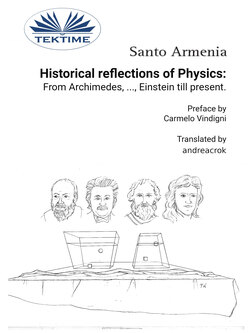Читать книгу Historical Reflections Of Physics: From Archimedes, ..., Einstein Till Present - Santo Armenia - Страница 5
Introduction
ОглавлениеSince the down of time philosophers considered the weight of bodies unalterable.
Euclid based his geometry on the fundamental entities (point, line and plane) and on postulates. One above all: between two points passes one and only one straight line. Geometry is a human construction, non-existing in the natural world.
Archimedes developed his studies in two fields:
1 geometry;
2 nature.
The geometry field includes the evaluation of the perimeter of flat shapes, the evaluation of the surface of flat shapes, the evaluation of the volume of solid shapes, the assessment of the barycentre of flat and solid shapes, etc.
The natural field includes the balance of bodies, the study of the buoyancy phenomenon etc.
Archimedes, confident of the sufficient reason principle or due to a spontaneous knowledge, developed his studies on nature basing it on postulates.
Modern and contemporary Physics (classical, relativistic and quantum), from Galileo till present, despite the definition of being experimental, are still built on postulates based on which theory after theory is constructed.
In this study the millennial mistake will be underline, an error derived from the postulate of considering the weight of bodies unalterable, even though it was outdated by Newton’s universal law of gravity, based on which the weight of bodies changes with their position (variation of distance from the centre of the earth), as a matter of fact it persists and with the passing of time it exacerbates.
This millennial mistake includes at present three of them:
1 - Newton himself considered the weight of bodies unchangeable with their shape;
2 - about forty years ago the Scientific Community established that scales (with equal arms, analogues and digital) do not measure the weight but the mass of bodies;
3 - from the 20th May 2019 the Scientific Community, looking to redefine the fundamental physical quantities, hasn’t established the standard sample nor the fabric or the sizeable shape for the kg mass.
Once the detailed knowledge of Kebble’s Scale (used to redefine the kg per mass) will be spread publicly, it will be known if there is or there isn’t a forth mistake, depending on the regular or the irregular shape of the system (the regular shape is achieved as a mere coincidence and not as a willing choice).
The historical era is divided into three periods:
1 - ancient, from Archimedes to Galileo;
2 - modern, from Newton to Lorànd Eötvös;
3 - contemporary, from Einstein till present.
From the historical research on the present study, news insights emerged:
a) the study of buoyant bodies;
b) the study of hanging/rolling bodies.
